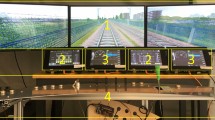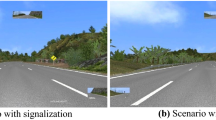Abstract
Drivers’ ability to perform the primary task of driving a vehicle and be able to handle the interference caused by the secondary tasks such as the use of cell phone is greatly influenced by their driving experience. In this study, thirty-eight drivers with different levels of driving experience were studied to evaluate their driving performance during simple versus complex driving tasks performed with and without cell phone. The driving performance was evaluated by studying the visual behavior of the drivers using eye-tracking systems, driving error, and subjective workload assessment tool. Results demonstrate that the novice drivers fixated more on the dashboard area (36.33%) than on the front and center view (14.33%). On the other hand, the experienced drivers fixated more on the front and center (39.5%) as compared to the dashboard area (12%). Same trend was observed for complex driving but with lower percentage of total fixations than the simple driving conditions. The visual distraction caused by secondary task of cell phone use contributes to the decline in driving performance. Although all drivers reported higher workloads during driving while using cell phones and committed more driving errors, the errors were comparatively lower for experienced drivers than the inexperienced drivers.







Similar content being viewed by others
References
Balk S, Moore K, Steele J, Spearman W, Duchowski A (2006) Mobile phone use in a driving simulation task: differences in eye movements. J Vis 6(6):872
Beede K, Kass S (2006) Engrossed in conversation: the impact of cell phones on simulated driving performance. Accid Anal Prev 38(2):415–421
Cantin V, Lavallière M, Simoneau M, Teasdale N (2009) Mental workload when driving in a simulator: effects of age and driving complexity. Accid Anal Prev 41(4):763–771
Cellular Telecommunication and Internet Association (2009) Background on CTIA’s semi-annual wireless industry survey. http://files.ctia.org/pdf/CTIA_Survey_Year_End_2009_Graphics.pdf. Accessed March, 2010
Collet C, Clarion A, Morel M, Chapon A, Petit C (2009) Physiological and behavioural changes associated to the management of secondary tasks while driving. Appl Ergon 40(6):1041–1046
Consiglio W, Driscoll P, Witte M, Berg W (2003) Effect of cellular telephone conversations and other potential interference on reaction time in a braking response. Accid Anal Pre 35(4):495–500
Crundall D, Underwood G, Chapman P (1999) Driving experience and the functional field of view. Perception 28:1075–1088
Fuse T, Matsunaga K, Shidoji K, Matsuki Y, Umezaki K (2001) The cause of traffic accidents when drivers use car phones and the functional requirements of car phones for safe driving. Int J Veh Des 26(1):48–56
Gugerty L, Rakauskas M, Brooks J (2004) Effects of remote and in-person verbal interactions on verbalization rates and attention to dynamic spatial scenes. Accid Anal Pre 36(6):1029–1043
Hancock PA, Lesch M, Simmons L (2003) The distraction effects of phone use during a crucial driving maneuver. Accid Anal Prev 35(4):501–514
Hart SG, Staveland LE (1988) Development of NASA-TLX (Task Load Index): results of empirical and theoretical research. Human Ment Workload 1:139–183
Hayashi M, Beutter B, McCann R (2005) Hidden Markov model analysis for space shuttle crewmembers’ scanning behavior. In: Paper presented at the IEEE international conference on systems, man and cybernetics, Waikoloa, Hawaii, Waikoloa, Hawaii, 10–12, October
Jahn G, Oehme A, Krems JF, Gelau C (2005) Peripheral detection as a workload measure in driving: Effects of traffic complexity and route guidance system use in a driving study. Transport Res Part F Traffic Psychol Behav 8(3):255–275
Kass S, Cole K, Stanny C (2007) Effects of distraction and experience on situation awareness and simulated driving. Transport Res Part F Traffic Psychol Behav 10(4):321–329
Laberge J, Scialfa C, White C, Caird J (2004) Effects of passenger and cellular phone conversations on driver distraction. J Transport Res Board 1899:109–116
Liu A (1998) What the driver’s eye tells the car’s brain. Eye guidance in reading and scene perception. Chapter 20:431–452
McEvoy S, Stevenson M, McCartt A, Woodward M, Haworth C, Palamara P, Cercarelli R (2005) Role of mobile phones in motor vehicle crashes resulting in hospital attendance: a case-crossover study. Br Med J 331(7514):428
McKnight A, McKnight A (1993) The effect of cellular phone use upon driver attention. Accid Anal Prev 25(3):259–265
National Highway Traffic Safety Administration (NHTSA) (1997) An investigation of the safety implications of wireless communications in vehicles. http://www.nhtsa.dot.gov/people/injury/research/wireless. Accessed April 2010
National Highway Traffic Safety Administration (NHTSA) (2004) Cell phone use on the roads in 2002. http://www-nrd.nhtsa.dot.gov/Pubs/809580.pdf. Accessed Apri, 2010
National Highway Traffic Safety Administration (NHTSA) (2009) Traffic safety facts. http://www-nrd.nhtsa.dot.gov/Pubs/811216.pdf. Accessed March 2010
Patten CJD, Kircher A, Östlund J, Nilsson L, Svenson O (2006) Driver experience and cognitive workload in different traffic environments. Accid Anal Prev 38(5):887–894
Rasmussen J (1987) Cognitive control and human error mechanisms. In: New technology and human error. Wiley, New York. p 53
Redelmeier D, Tibshirani R (1997) Association between cellular-telephone calls and motor vehicle collisions. N Engl J Med 336(7):453
Schattler K, Pellerito J, McAvoy D, Datta T (2006) Assessing driver distraction from cell phone use: a simulator-based study. J Transport Res Board 1980:87–94
Shinar D, Tractinsky N, Compton R (2005) Effects of practice, age, and task demands, on interference from a phone task while driving. Accid Anal Prev 37(2):315–326
Shutko J, Mayer K, Laansoo E, Tijerina L (2009) Driver workload effects of cell phone, music player, and text messaging tasks with the sync-voice interface versus the devices’ handheld visual-manual interfaces. SAE International
Smiley A, Smahel T, Donderi D, Caird JK, Chisholm S, Lockhart J, Teteris E (2007) The effects of cell phone and CD use on novice and experienced driver performance. http://www.ibc.ca/en/Car_Insurance/documents/road_safety/DriverDistraction_full_study_jan2007.pdf
Sodhi M, Reimer B, Cohen J, Vastenburg E, Kaars R, Kirschenbaum S (2002) On-road driver eye movement tracking using head-mounted devices. In: Proceedings of the 2002 symposium on eye tracking research and applications, New Orleans, Louisiana, ACM. p 68
Strayer D, Johnston W (2001) Driven to distraction: dual-task studies of simulated driving and conversing on a cellular telephone. Psychol Sci 12(6):462–466
Strayer D, Drews F, Johnston W (2003) Cell phone-induced failures of visual attention during simulated driving. J Exp Psychol Appl 9(1):23–32
Stutts J, Reinfurt D, Staplin L, Rodgman E (2001) The role of driver distraction in traffic crashes. AAA Foundation for Traffic Safety, Washington
Underwood D (1998) Effects of experience and processing demands on visual information acquisition in drivers. Ergonomics 41(4):448–458
Waard D, Brookhuis K, Hernandez-Gress N (2001) The feasibility of detecting phone-use related driver distraction. Int J Veh Des 26(1):85–95
Wang J, Knipling R, Goodman M (1996) The role of driver inattention in crashes: New statistics from the 1995 crashworthiness data system. In: 40th Annual proceedings: association for the advancement of automotive medicine. pp 377–392
Author information
Authors and Affiliations
Corresponding author
Rights and permissions
About this article
Cite this article
Nabatilan, L.B., Aghazadeh, F., Nimbarte, A.D. et al. Effect of driving experience on visual behavior and driving performance under different driving conditions. Cogn Tech Work 14, 355–363 (2012). https://doi.org/10.1007/s10111-011-0184-5
Received:
Accepted:
Published:
Issue Date:
DOI: https://doi.org/10.1007/s10111-011-0184-5




